Triloading 101
It’s important to understand the strength ratings of your various equipment. Carabiners are rated for a couple of different types of loading, and without exception the pull-load (coincident with the spine of the carabiner) is the highest rating. Loads in other directions (pulling on the gate, for instance) are usually substantially lower. Simply put, this means you should have your loads pulling down the spine of the carabiner, and not at off-angles.With lifting equipment, strength ratings are usually given in a more comprehensive manner, with both safe working loads, and ultimate break strength. Climbing gear only gives you the UBS, sadly. Likewise, in lifting, there are load angle charts that can be used to determine if you are loading in a safe way. Climbing doesn’t offer these, but with a bit of personal speculation, I believe they can be partially adapted.
Here’s an example of what I would consider “acceptable” loading for a lowline. This sort of tri-loading is going to reduce the break strength of the carabiner, but not to an unsafe degree (for a lowline!), in my opinion. As with anything, use your discretion. I accept this as safe because the loads on the line (with user on line) are in the range of 3-5Kn (and major axis rating is 20+Kn).
Here’s an example of tri-loading that I wouldn’t trust. There is just not enough safety factor involved here. On an industrial lift sling, this would reduce the break strength to about 50%. On a carabiner not designed for tri-loading, it might even be 25% of major axis after repeated use in this manner (aluminum can fatigue in weird ways). Scary.
The best solution involves an extra carabiner and rappel ring (per anchor).
A couple more shots of a lowline “continuous anchor sling” held together with an extra carabiner, with a threaded rap ring.
Lastly, here’s an example of a tri-load calculation chart that is included with an industrial lift sling (crane hauling sling)…


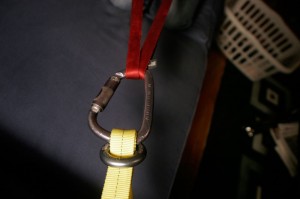
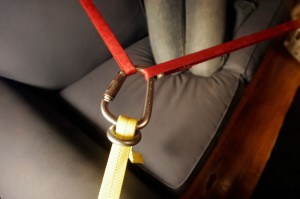
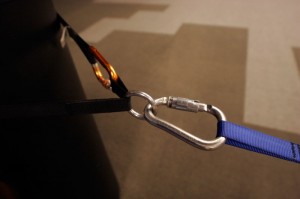
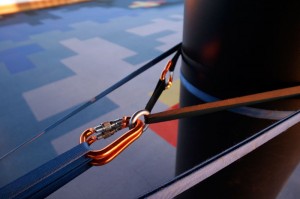
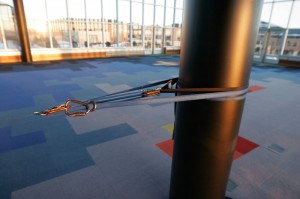
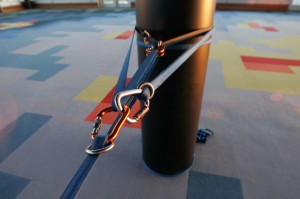
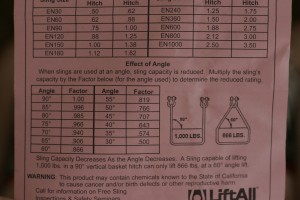
is the second biner on the last photo your mainline used as a backup? do you like the omega rap rings?
nice clean setup you have. good shots too.
EDIT — Thanks for the comment. The carabiner in the last photo is a backup, yea. It’s attached to the “tail” from the tightening system, and clipped in to keep the system from coming lose, plus as a loose backup in case something in the tightening system fails. Normally I would just tie it off instead of using a biner, but since I was going to take a photo, I made it pretty.
I like the omega rings, but they do “ding” easily since they are aluminum. Eventually they will bend enough to need retirement, although I have yet to get to that point (with a lot of use, too!). Madrock is selling their version of the ring for cheaper ($2.95 vs $4-5 for the Omega rings at REI) on their web site. The site actually says $1 or $1.50 — if you call they will honor this price. I bought a dozen or so, since this is such a good deal (and they are really useful). For anything under serious tension, I use steel hardware (biners and rings). Steel rings are readily available for cheap a couple of places, I prefer RenoB (pics and some more explanation here http://forum.slackline.com/modules.php?name=Forums&file=viewtopic&p=11570 — I post there as “Aspherical”).
Thanks for this.
I recently decided to add two extra rap rings on both sides of my set-up to eliminate tri-loading (before I was using the basic primitive set-up you had in your videos).
The different thing I did from your set-up is instead of using an extra biner on the anchor to tie the ends of the slings together (am I making sense?), I just hitched the ends together.
Do you think this is a negligeble enough modification that it wouldn’t compromise the anchor too much?
I love this site btw, it got me going with my first slackline 🙂
Chi
Answer: I think you are saying you girth-hitched the anchor sling through itself … that is an acceptable but sub-optimal practice. I would not do this for lines under high tension. In general, when rigging, this reduces the strength of the material by up to 50%. Maybe with a piece of innertube or some padding (to prevent friction) it could retain 100% strength. Maybe. For short lines I think it doesn’t matter much since the tensions are low.